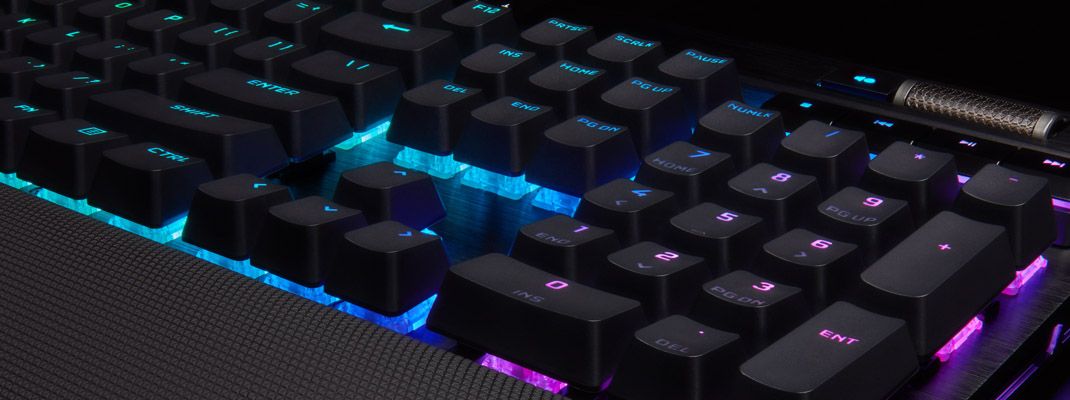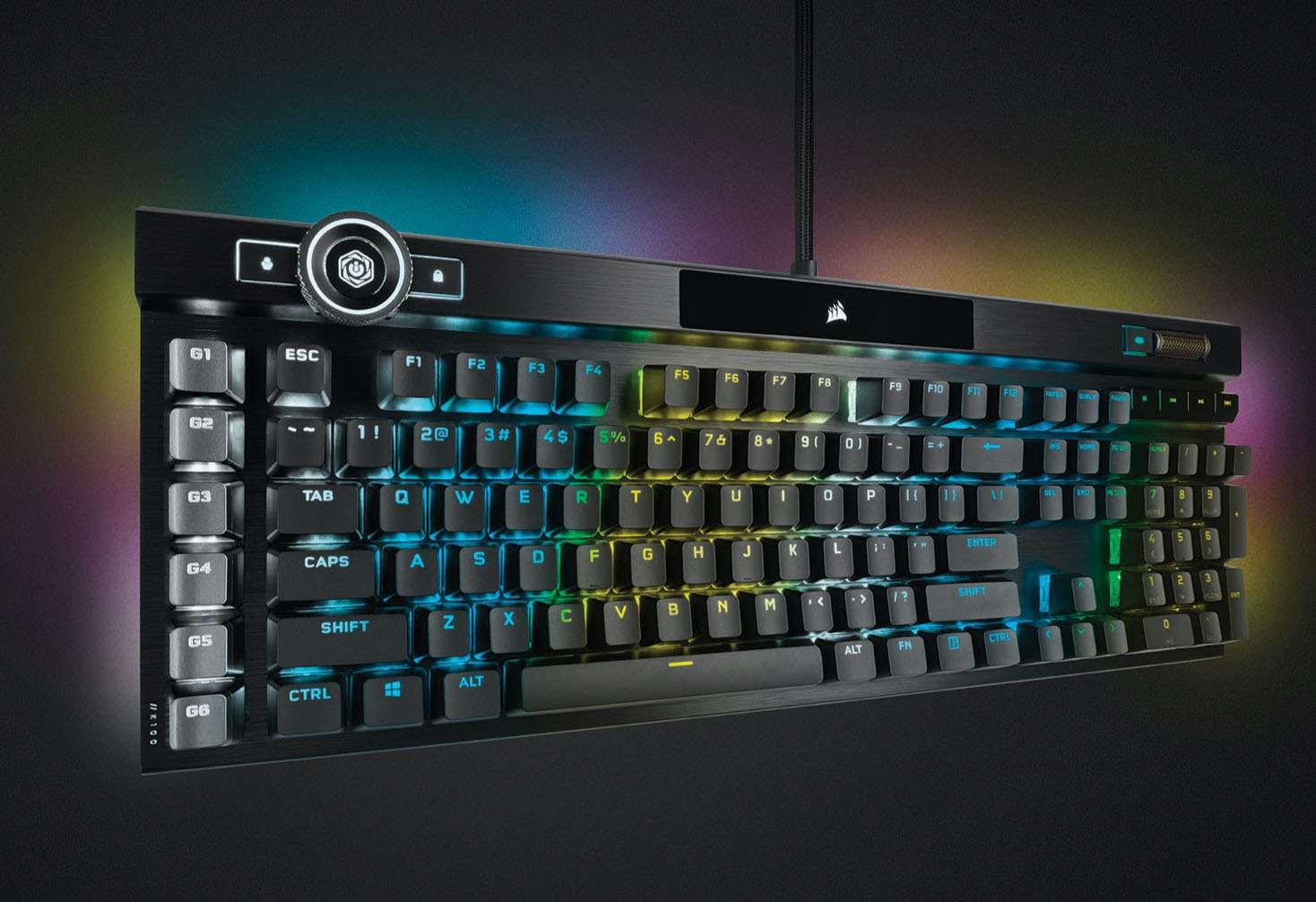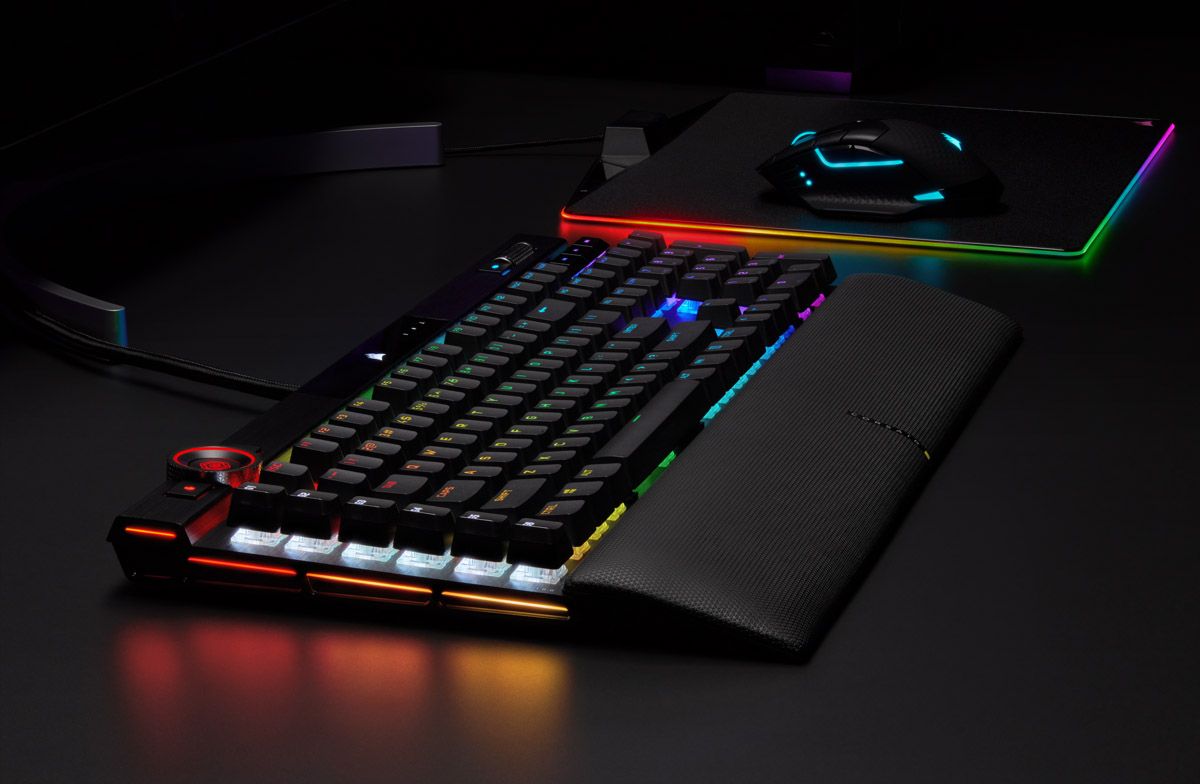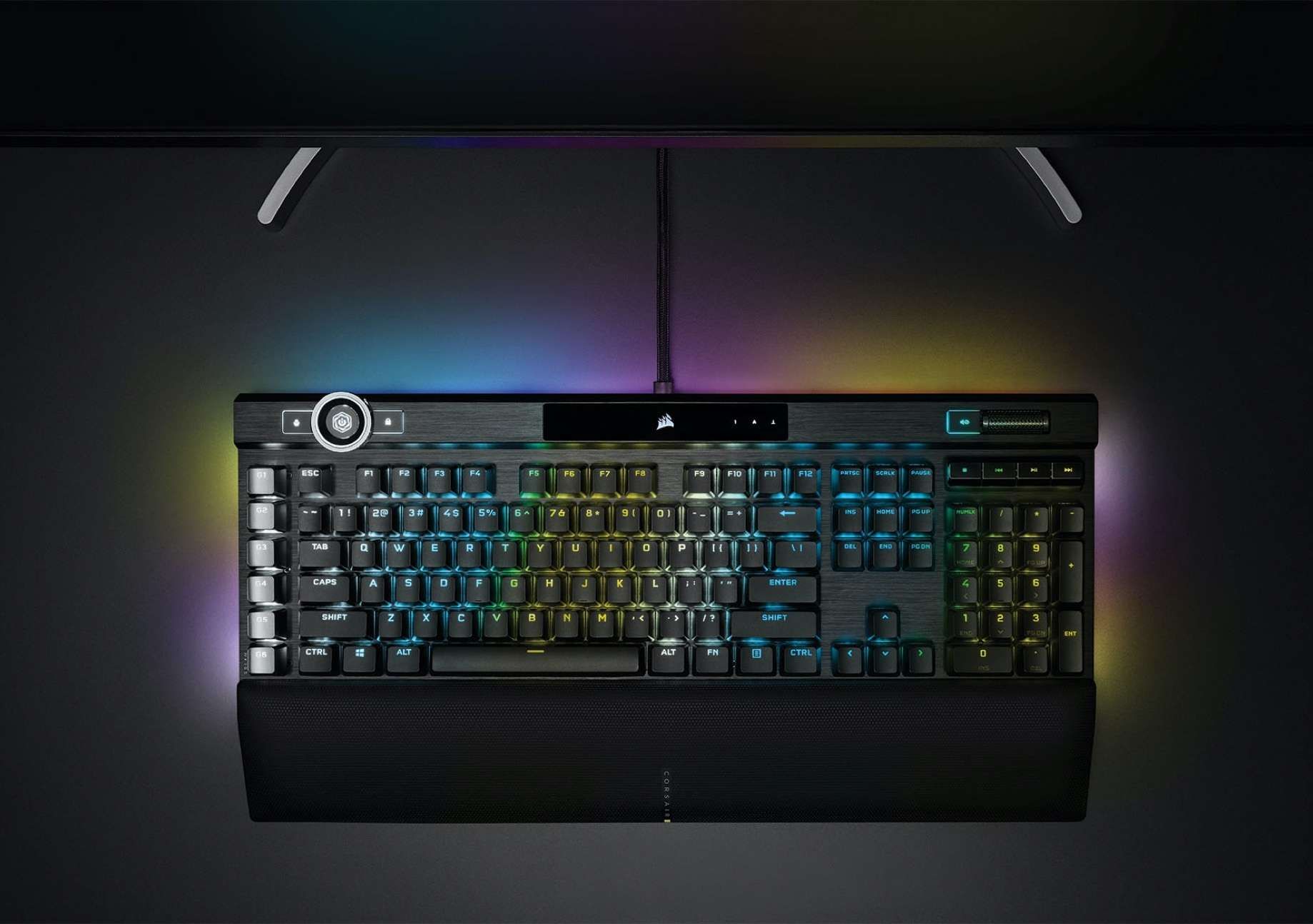Corsair’s flagship keyboard, the K95 Platinum, has been out for quite some time now, with slight iterations having come over the last three-and-a-half years. While it still remains a fantastic keyboard with a lot of options, Corsair is looking to up their game and introduce a brand new device that will be a front runner for best gaming keyboard on the market. The K100 takes all of the aspects of the K95 and not only improves upon its design and features, but streamlines a number of components. From improved RGB lighting all the way through to an integrated iCue Control Wheel, the K100 has a lot of improvements that should have fans excited.
In an age of options, there are two different models available for the K100 keyboard: Cherry MX Speed Silver, and OPX keyswitches. We were able to try out the Speed Silver which offers linear characteristics, 45 cN operating force and 1.2mm actuation (with up to 100 million guaranteed keypresses). The Speed Silver in general feels incredible for both gaming and regular activities. It’s more of a personal choice as I’ve used Tactile for what feels like a decade now, but the quieter and faster means of pressing your keys (as they require far less operating force) converted me into the linear category.
The design of the K100 is one of the most appeasing elements to the keyboard. Having used the Corsair K95 Platinum XT keyboard for a while now, this feels slightly more streamlined in its design to be less bulky. For starters, the profile, lock and mute actions are no longer cylindrical, large buttons that stick out of the top of the device. Instead, they are rectangular (mostly) and look like they’re part of the actual design instead of something that’s drastically different from the rest of the keys. Even the volume scroll wheel is black instead of silver, which perfectly blends in. Speaking of which, one of my biggest complaints with the K95 is the scroll wheel was too stiff -- it took far too much pressure to actually scroll -- but the K100 has a lot of freedom to move which allows you to essentially brush your finger up or down and it will work without much extra effort. With that said, I would have loved if the newly-designed buttons had more of a clicky feel as there’s not much weight to them. There's a little bit of a click, but the distance from pressing down is small to the point it may as well be touch sensitive. OK, that may be a bit of an exaggeration, but they standout compared to the 114 other keys.
The Corsair logo at the top of the device also is functional in both lighting and displaying a number of indicators, including mute, macro recording, caps, win lock, num lock and scroll lock. Even though they are small indicators, it's refreshing and once again feels like it’s built into the keyboard itself. The best example I can think of the original Xbox One controller had such a bulky, angular design, but Microsoft iterated upon it and made something that more natural. The K100 also comes with a set of textured keycaps for the standard WASD, but also features QWERDF as an alternative for additional support depending on your preference. I personally would have preferred the six macro keys on the side to come with their own textured keycaps like in previous iterations of the K95. At least the keycaps feel a little bit better than what Corsair has used in the past. They’re not as deep, but the texture feels a lot finer compared to the roughness of the past. Corsair has also finally removed the textured space bar, which I'm very much in favor for. It wasn’t bad by any means, but felt out of place, especially if you didn’t use the keycaps in the first place. The media control under the scroll wheel has been slightly adjusted to look a lot less bulky. Instead of having overly large buttons, Stop, Back, Play/Pause and Forward are small caps ontop of a little box. They still retain a little bit of the bevel we’ve become used to, but they’re a lot more pleasing to the eyes and even comes with LED lighting behind.
The K100 also includes a plushed wrist rest, but while it’s an improvement over what we’ve come to expect from Corsair, it still could use some work. On one hand, there's no bezel around the plush. Instead, it goes around the plastic material ensuring you’ll always have your wrists on the cushioned portion. It also features a magnetic connection, so you can just slot it in and out without any hassle. On the other hand, because it’s magnetic, you won’t be able to swap out the wrist rest with older models if you don’t like it. Also, this is a little bit more firm than the K95 Platinum XT. This will be a personal taste, as it’s still decently cushioned and great to use, but compared to other wrist rests on the market, it’s not the be all end all in terms of comfort. Outside of that, the K100 comes with a black anodized brushed aluminum chassis, weighs 1.35kg (2.96lbs) and of course has legs to adjust height and the angle.
As usual, the RGB Lighting uses Corsair’s iCue application, which allows you to change and layer the lighting patterns to your liking. Corsair’s new keyboard design also allows for even more RGB effects, as the sides, back and all of the keys have their own individual LED lighting. The only thing that's missing is the bottom of the device. Corsair probably assumes you will use their comfortable wrist pad so you wouldn’t see any coloring down there anyway, at least until we get transparent rests. The six side macros aren’t the only keys that can be reprogrammed, either, as the entire keyboard can be reworked to how you see fit. Rarely use that + key on the numeric keypad? Why not assign it to record with Shadowplay or another application. There’s endless possibilities when it comes to reworking the K100, to the point even the media control buttons can operate in a drastically different way.
One of the major new features is the iCue Control Wheel. This acts as a multi-functional device where you’re able to do various tasks without using any third-party applications via (mostly) hardware. So for example, depending on the mode you’re on (indicated by a color), you can adjust the brightness, track jogging with specific programs such as Spotify, track selecting and macro recording in hardware mode. In software mode, you can swap between applications, scroll vertically and horizontally (which I found the least useful of all the modes), zooming, and of course customizing your own actions. This has an incredible amount of power, but it has a steep learning curve. Additionally, I had a lot of difficulty programming the device and customizing my own actions. The onboard settings work magically, but actually setting up the Control Wheel was a bit of a headache. Regardless, after you can get over some of the hurdles, there’s a lot of functionality built into such a small wheel.
Finally, the biggest evolution to the Corsair keyboard is the Axon hyper-processing technology. The whole purpose of this new processing power is to increase your throughput by 4x the speed via multi-threaded processing built into the device. It decreases the input time from keyboards that go anywhere between 2-10ms down well below 1ms ensuring each input is recognized at record speeds. The poling of the Corsair K100 goes from anywhere between 8ms to .25ms, which is astronomically fast. Can most users feel the difference between 1ms and .25ms? Probably not. But if you’re used to anything below 1000 Hz, you’ll immediately feel the difference, especially in games.
Closing Comments:
Mechanically speaking, the Corsair K100 is a sizable step over its predecessor for giving you the edge in gaming thanks to the AXON hyper-processing technology. It has all the bells and whistles you’ve come to expect from a gaming keyboard, be it the impressively customizable RGB lighting or the numerous macro keys on the side. The iCue Control Wheel also offers massive functionality with a single twist. It does have a rather steep learning curve, and I had a lot of trouble actual customizing actions, but once you’ve mastered it, you’ll be navigating your computer like you’ve never done before. There are some aspects I wish would be altered, though. While the lock button will change to solid red when pressed, that can’t be said about the mute button, as it’s instead displayed on the Corsair panel at the top of the keyboard. This could have simply been a solid red color as well, instead of having to look all the way to the left to identify if you’re muted. These buttons in general, while a drastic improvement over their predecessors, could have had a better feel when pressed as they’re too light and don’t have a satisfying click like the rest of the keyboard. Regardless, these are minor gripes to the various improvements Corsair has implemented. Even at the relatively expensive $229.99 price point, the Corsair K100 is a worthwhile investment if you’re looking for the best and flashiest gaming accessory out there.




